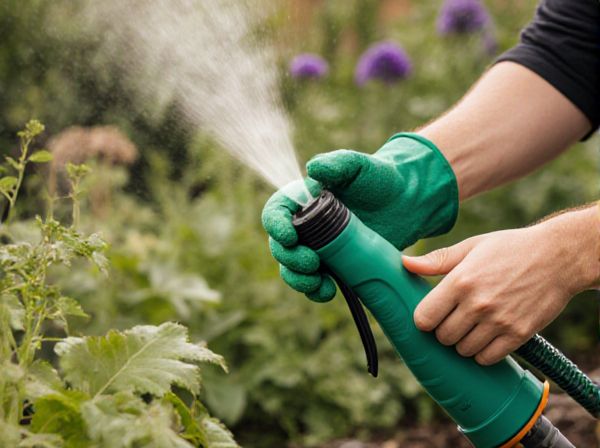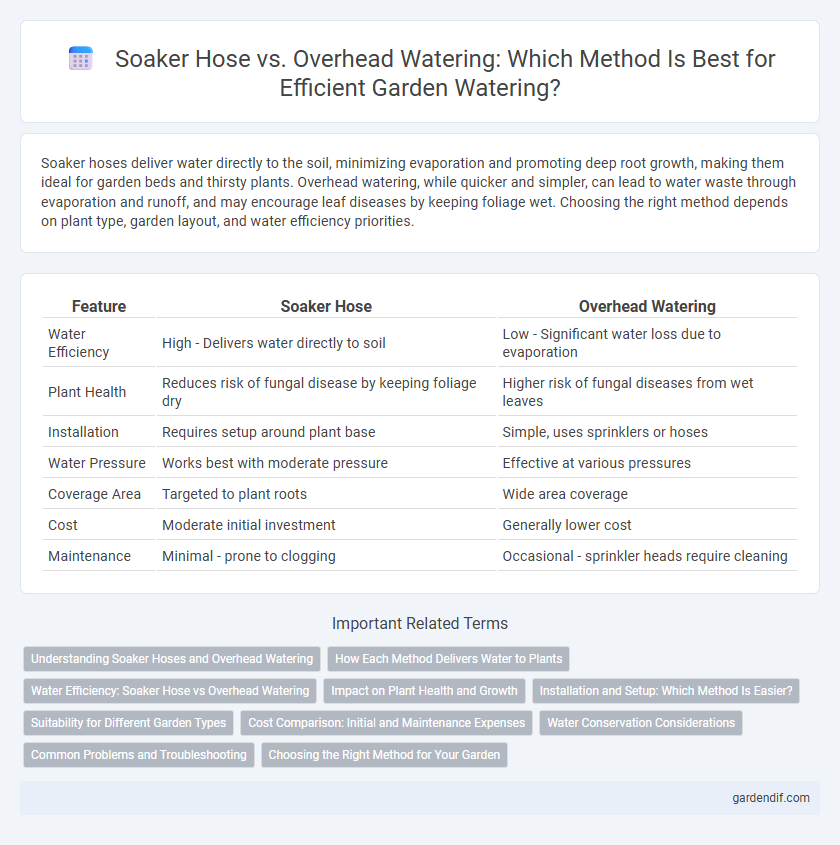
Soaker hose vs Overhead watering Illustration
Soaker hoses deliver water directly to the soil, minimizing evaporation and promoting deep root growth, making them ideal for garden beds and thirsty plants. Overhead watering, while quicker and simpler, can lead to water waste through evaporation and runoff, and may encourage leaf diseases by keeping foliage wet. Choosing the right method depends on plant type, garden layout, and water efficiency priorities.
Table of Comparison
| Feature | Soaker Hose | Overhead Watering |
|---|---|---|
| Water Efficiency | High - Delivers water directly to soil | Low - Significant water loss due to evaporation |
| Plant Health | Reduces risk of fungal disease by keeping foliage dry | Higher risk of fungal diseases from wet leaves |
| Installation | Requires setup around plant base | Simple, uses sprinklers or hoses |
| Water Pressure | Works best with moderate pressure | Effective at various pressures |
| Coverage Area | Targeted to plant roots | Wide area coverage |
| Cost | Moderate initial investment | Generally lower cost |
| Maintenance | Minimal - prone to clogging | Occasional - sprinkler heads require cleaning |
Understanding Soaker Hoses and Overhead Watering
Soaker hoses deliver water directly to the soil, reducing evaporation and promoting deep root growth, making them ideal for garden beds and efficient water use. Overhead watering sprays water above the plants, which can increase evaporation and may lead to leaf diseases if foliage remains wet for extended periods. Understanding these differences helps gardeners choose the best method for specific watering needs and plant health optimization.
How Each Method Delivers Water to Plants
Soaker hoses deliver water directly to the soil through tiny pores along the hose, ensuring deep, even hydration at the root level while minimizing evaporation. Overhead watering sprays water from above using sprinklers or hoses, covering a broader surface but often resulting in more water loss due to evaporation and runoff. The precision of soaker hoses promotes efficient water use and healthier plant roots compared to the less targeted application of overhead watering.
Water Efficiency: Soaker Hose vs Overhead Watering
Soaker hoses deliver water directly to the soil, minimizing evaporation and runoff, which significantly enhances water efficiency compared to overhead watering methods. Overhead watering often results in water loss due to wind drift and evaporation, especially during hot or windy conditions. Using soaker hoses can reduce water usage by up to 50%, making them a more sustainable option for maintaining garden health.
Impact on Plant Health and Growth
Soaker hoses deliver water directly to soil, minimizing leaf wetness and reducing the risk of fungal diseases, which promotes healthier root development and improved plant growth. Overhead watering can cause water to sit on leaves, increasing susceptibility to mildew and blight, often leading to stunted growth or plant stress. Consistent moisture from soaker hoses ensures optimal nutrient absorption, enhancing overall plant vitality compared to the variable coverage of overhead sprinklers.
Installation and Setup: Which Method Is Easier?
Soaker hoses require simple installation by laying the hose along garden beds and connecting to a water source, minimizing setup time and effort. Overhead watering systems typically involve mounting sprinklers or spray heads, requiring more tools and precise placement for effective coverage. The ease of installation makes soaker hoses a preferred choice for gardeners seeking a quick, low-maintenance watering solution.
Suitability for Different Garden Types
Soaker hoses are ideal for garden beds, vegetable patches, and flower borders because they deliver water directly to the soil, reducing evaporation and minimizing fungal diseases on foliage. Overhead watering suits lawns and larger areas where coverage and convenience are priorities, though it may increase water loss and promote leaf diseases in sensitive plants. Choosing between soaker hoses and overhead watering depends on plant types, garden layout, and water conservation goals.
Cost Comparison: Initial and Maintenance Expenses
Soaker hoses typically have lower initial costs, averaging $20 to $50, while overhead watering systems can range from $100 to $300 due to complex installation and equipment needs. Maintenance expenses for soaker hoses are minimal, mostly involving occasional unclogging or repairs, whereas overhead systems require regular checks and replacement of sprinkler heads, increasing long-term costs. Choosing a soaker hose provides a budget-friendly option with reduced water waste, making it cost-effective for garden irrigation.
Water Conservation Considerations
Soaker hoses deliver water directly to the soil surface, reducing evaporation loss and promoting deep root growth, which enhances water conservation. Overhead watering methods often result in significant water runoff and evaporation, leading to inefficient water use. For sustainable irrigation, soaker hoses optimize water delivery by targeting plant roots and minimizing waste.
Common Problems and Troubleshooting
Soaker hoses often face issues such as clogging due to sediment buildup and uneven water distribution caused by kinks or improper placement. Overhead watering can lead to common problems like leaf diseases from wet foliage and water waste due to wind drift or spray evaporation. Troubleshooting involves regularly flushing soaker hoses to clear blockages and adjusting sprinkler heads or watering times to minimize evaporation and prevent plant damage.
Choosing the Right Method for Your Garden
Soaker hoses deliver water directly to the soil, reducing evaporation and promoting deep root growth, making them ideal for garden beds with dense plantings. Overhead watering mimics natural rainfall, providing quick coverage but increasing the risk of leaf diseases due to prolonged wet foliage. Selecting the right method depends on your plant types, soil conditions, and watering efficiency preferences to ensure optimal garden health.
Soaker hose vs Overhead watering Infographic

 gardendif.com
gardendif.com